Issue Archive
Table of Contents
BLOOD COMMENTARIES
CLINICAL TRIALS AND OBSERVATIONS
A phase 1 trial of fully human BCMA CAR-T therapy for relapsed/refractory multiple myeloma with 5-year follow-up
Clinical Trials & Observations
Relapsed/refractory (R/R) multiple myeloma (MM) remains a significant therapeutic challenge. Tuazon and colleagues report the long-term results from their phase 1 study of FCARH143, a fully human B-cell maturation antigen (BCMA)–targeted chimeric antigen receptor (CAR) T-cell therapy, for patients with R/R MM. This therapy had high efficacy, with 68% of patients achieving stringent complete response at a median follow-up of 67.3 months. The median progression-free survival was 15.5 months, with the median overall survival reaching 32 months. These promising results require confirmation in large multicenter studies.
HEMATOPOIESIS AND STEM CELLS
Heterogeneity of high-potency multilineage hematopoietic stem cells and identification of “Super” transplantability
What determines how successful a hematopoietic stem cell (HSC) is at engrafting and subsequently producing a balanced output of blood cells? In this study, Dong et al partially answered that question by performing mouse studies in which they combined single-HSC transplantation and single-cell transcriptomic profiling to comprehensively describe the heterogeneity within the most potent multilineage HSCs. They identified rare CD27-negative HSCs, termed Super-HSC clones, with superior long-term and balanced engraftment. These robust preclinical studies provide novel insights into HSC biology and set the basis for future human studies.
IMMUNOBIOLOGY AND IMMUNOTHERAPY
Modeling the HLH immune synapse uncovers critical roles for IS termination, cytokine intensity, and target cell death
Hemophagocytic lymphohistiocytosis (HLH) is a life-threatening systemic hyperinflammatory disorder characterized by cytotoxic T-lymphocyte (CTL) activation and overproduction of interferon gamma. In this study, Frank-Kamenetskii and colleagues, using an established mouse model of HLH, identified differential mechanisms of HLH-type hyperinflammation at the level of the immune synapse (IS) communication node and found an impaired termination signal between CTLs and target cells, as well as a receptor-interacting protein kinase 1 (RIPK1)–dependent necroptotic cell death pathway leading to hyperinflammation. This study sheds new light on HLH pathophysiology and provides a potential platform for testing novel therapies.
LYMPHOID NEOPLASIA
Clonal hematopoiesis is clonally unrelated to multiple myeloma and is associated with specific microenvironmental changes
The role of clonal hematopoiesis (CH) in outcomes for patients with lymphoid malignancies remains poorly understood. In this study, Lionetti and colleagues used targeted next-generation sequencing in a cohort of 106 patients with newly diagnosed multiple myeloma (MM) and identified CH in 22.6%. While they found that there is no common clonal origin for these 2 diseases, patients with CH exhibited an increased proinflammatory tumor microenvironment (TME) compared to patients without CH. These results should prompt further investigation in larger cohorts to better understand the role of CH in the TME in MM and its effects in disease outcomes.
NGS-based IG/TR gene rearrangement profiling in acute lymphoblastic leukemia: age dependence of immunogenetic maturation
Brief Report
The use of next-generation sequencing (NGS) in acute leukemia has improved classification and guided treatment decisions. In this study, Kotrová and colleagues performed targeted NGS of >1000 leukemia samples to provide a comprehensive analysis of the prevalence of V(D)J rearrangements across distinct subtypes and age groups in acute lymphoblastic leukemia (ALL), highlighting the higher immunogenicity maturity in children compared to adults. These findings should be further investigated in large, well-phenotyped ALL cohorts to determine their full clinical and therapeutic implications.
MYELOID NEOPLASIA
Magrolimab plus azacitidine vs physician’s choice for untreated TP53-mutated acute myeloid leukemia: the ENHANCE-2 study
Clinical Trials & Observations
TP53-mutated acute myeloid leukemia (AML) is associated with an extremely poor prognosis and resistance to standard treatments. Zeidner and colleagues report the results of the ENHANCE-2 trial, a prospective phase 3 clinical trial evaluating the anti-CD47 monoclonal antibody magrolimab plus azacitidine in the difficult-to-treat TP53 mutation population through comparisons to the azacitidine-venetoclax combination in patients ineligible for intensive treatment or to the intensive standard 7+3 chemotherapy in fit patients. Interim analysis indicated futility, and the final results are negative for both randomized comparisons. In the randomized ENHANCE-3 trial, Daver and colleagues asked whether magrolimab improves outcomes when added to standard therapy with combinations of venetoclax and hypomethylating agents in older and unfit patients with AML. The responses were similar in both arms, but fatal adverse events were more common in the magrolimab arm. These 2 negative trials highlight the difficulty of improving outcomes in AML ineligible for intensive chemotherapy or AML with TP53 mutations.
The ENHANCE-3 study: venetoclax and azacitidine plus magrolimab or placebo for untreated AML unfit for intensive therapy
Clinical Trials & Observations
TP53-mutated acute myeloid leukemia (AML) is associated with an extremely poor prognosis and resistance to standard treatments. Zeidner and colleagues report the results of the ENHANCE-2 trial, a prospective phase 3 clinical trial evaluating the anti-CD47 monoclonal antibody magrolimab plus azacitidine in the difficult-to-treat TP53 mutation population through comparisons to the azacitidine-venetoclax combination in patients ineligible for intensive treatment or to the intensive standard 7+3 chemotherapy in fit patients. Interim analysis indicated futility, and the final results are negative for both randomized comparisons. In the randomized ENHANCE-3 trial, Daver and colleagues asked whether magrolimab improves outcomes when added to standard therapy with combinations of venetoclax and hypomethylating agents in older and unfit patients with AML. The responses were similar in both arms, but fatal adverse events were more common in the magrolimab arm. These 2 negative trials highlight the difficulty of improving outcomes in AML ineligible for intensive chemotherapy or AML with TP53 mutations.
PHAGOCYTES, GRANULOCYTES, AND MYELOPOIESIS
Ruxolitinib targets JAK-STAT signaling to modulate neutrophil activation in refractory macrophage activation syndrome
Macrophage activation syndrome (MAS) is a rare and severe complication of adult-onset Still disease (AOSD). In these studies, Ma and colleagues, using a combination of animal models of MAS and several cohorts of patients with AOSD with or without MAS, demonstrated that neutrophil activation in MAS is mediated via JAK-STAT signaling. In their clinical studies, treatment with the JAK inhibitor ruxolitinib led to complete remission in the majority of patients with AOSD with MAS, dampening neutrophil activation and neutrophil extracellular trap formation. These findings open a new therapeutic approach to AOSD-associated MAS.
THROMBOSIS AND HEMOSTASIS
A multiomics approach reveals novel regulators of plasma factor V levels, highlighting CLEC4M as a clearance receptor
Coagulation factor V (FV) is involved in bleeding and thrombosis, but little is known about the genetic determinants of FV levels. Munsch and colleagues conducted a comprehensive bioinformatics analysis, including large-scale proteogenomic and transcriptomic data from original and public data sets, and identified 26 new proteins and genetic loci involved in the regulation of plasma FV levels. They reveal CLEC4M as a potential new clearance receptor for FV levels, showing that CLEC4M regulates FV clearance by binding and internalizing FV. This study identifies the first clearance receptor for FV.
TRANSPLANTATION
High incidence of severe TA-TMA increases mortality in adult allogeneic transplant recipients: a prospective MIDAS Consortium study
Clinical Trials & Observations
Vasu and colleagues report the results of the first prospective multicenter study on active screening for transplant-associated thrombotic microangiopathy (TA-TMA) in adult patients undergoing allogeneic hematopoietic stem cell transplantation (HCT). The study determines the incidence, risk factors, and mortality of TA-TMA by using newly harmonized diagnostic criteria. The authors show that the incidence of severe TA-TMA is higher than previously reported and that severe TA-TMA, but not less-severe TA-TMA, has a significant impact on overall survival and nonrelapse mortality.
BLOOD WORK
-
Cover Image
Cover Image
![issue cover]()
Hematoxylin and eosin–stained liver tissue from an infected interleukin-18–transgenic mouse shows a dense perivascular infiltrate of predominantly CD8+ T cells, hepatocyte necrosis, and disrupted architecture. Inhibition of necroptosis prevented hepatitis in this mouse strain, but not in infected Prf-1 knockout mice. See the article by Frank-Kamenetskii et al on page 558.
- PDF Icon Front MatterFront Matter
- PDF Icon Table of ContentsTable of Contents
- PDF Icon Editorial BoardEditorial Board
Advertisement intended for health care professionals
Email alerts
Advertisement intended for health care professionals


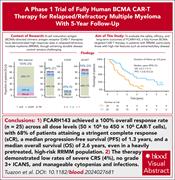
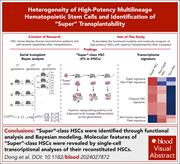
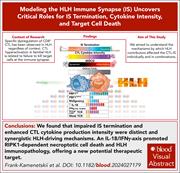
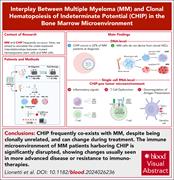
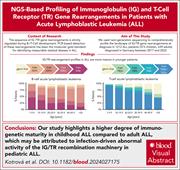
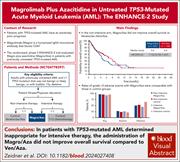
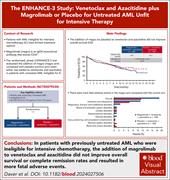
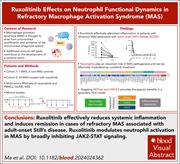
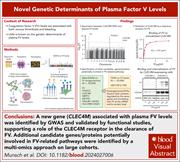
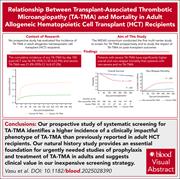

Time-tested safety: FCARH143’s 5-year myeloma journey
Clinical Trials & Observations